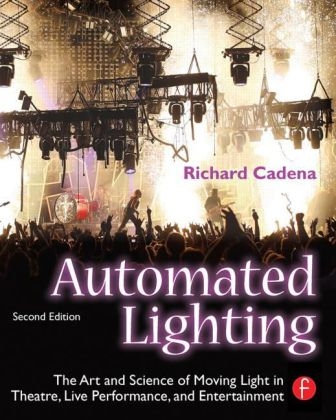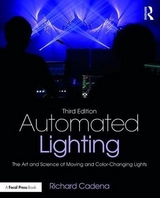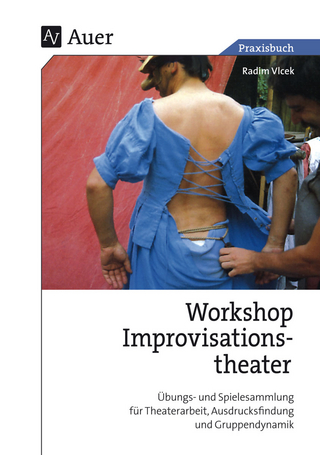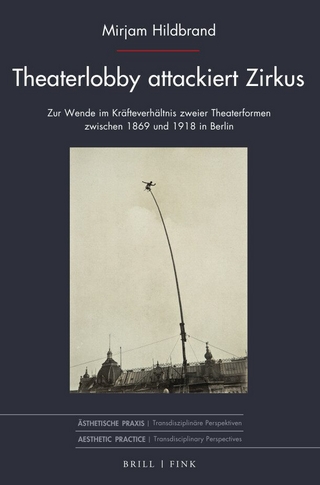
Automated Lighting
Focal Press (Verlag)
978-0-240-81222-9 (ISBN)
- Titel erscheint in neuer Auflage
- Artikel merken
Automated Lighting: The Art and Science of Moving Light in Theatre, Live Performance and Entertainment continues to be the most trusted text for working and aspiring lighting professionals. Now in its second edition, it has been fully updated to include new advances in lamp sources such as LEDs and plasma lamps, automated and programmable displays, updates for managing color, and new methods for using electronics. Its clear, easy-to-understand language also includes enough detailed information for the most experienced technician and engineer.
Richard Cadena is the author of "Focus on Lighting Technology," technical editor for PLASA, former editor of Pro Lights and Staging News magazine, an Authorized WYSIWYG Trainer, and 20 year veteran of the entertainment lighting industry including stints with two of the world's largest automated lighting manufacturers. He has a background in electrical engineering and electronics, and he is a freelance lighting designer with a portfolio of several major lighting designs and installations and is proficient in WYSIWYG, LD Assistant, and Vectorworks. He has been an instructor of classes in automated lighting technology with the Show Training Network, and a moderator of several lighting panels and seminars at Pro Production and Inspiration trade shows.
SECTION 1: Introduction to Automated Lighting 1
CHAPTER 1: Automated Lighting in the Third Millennium
CHAPTER 2: The Foundation of the Automated Lighting Industry
The Genesis of the Automated Lighting Industry
Synchronicity
"If We Can Make It Change Color . . ."
The Black Hole
For Sale: Automated Lighting
Sue Me, Sue You Blues
The Future of Automated Lighting
CHAPTER 3: Automated Lighting Systems
Systems Overview
Rigging Systems
Aluminum Structures
Theatrical Rigging
Rigging Hardware
Power Distribution Systems
Disconnect Switch
Feeder Cable
Distribution Panels and Portable Power Distribution Units (PPDUs) 1Overcurrent Protection
Dimmers
Branch Circuits
Wire Gauges
Voltage Drop
Connectors
Worldwide Electrical Safety and Wiring Codes
Compliance
Data Distribution Systems
Data Cables
Data Splitters
Data Amplifiers
Data Converters
Data Terminators
A/B Switches
Data Connectors
Control Systems
Automated Lighting Controllers
Automated Lighting Consoles
PC-Based Controllers
Dedicated Controllers
Playback Units
Remote Focus Units
Preset Stations
Media Servers
Redundant Backup Systems
Luminaires
Electrical Systems
Electronics Systems
Electromechanical Systems
Mechanical Systems Optical Systems
Communications Systems
SECTION 2: Electricity and Electronics
CHAPTER 4: DC Electricity
The Flow of Electrons
The Relative Size of Electrons
The Electron Drift Theory
Friction
Conductive Properties of Materials Current Convention
Voltage, Current, and Resistance
Water and Electricity-Bad Mix, Good Analogy
The DC Circuit Units of Measure-Current, Voltage, Resistance, Power
The Resistor Color Code
Resistor Wattage
Series Resistance
Parallel Resistance
Series/Parallel Resistance
Ohm's Law
Practice Problems
DC Power
Practice Problems
CHAPTER FIVE: Electricity and Magnetism
Magnetic Lines of Flux
Electromagnetic Induction
Inducing Current
Alternating Current
CHAPTER SIX: AC Electricity
The Alternating Current Generator
Peak Voltage
RMS Voltage
The Inductor
The Capacitor
Phase Relationships
Impedance
The Transformer
AC Power
Power Factor
Three-Phase Power
The Three-Phase Delta-Wye Configuration
Three-Phase Wye Connections
The Three-Phase Delta-Delta Configuration
Electrical Safety
Drugs and Alcohol
CHAPTER SEVEN: Power Supplies
The Diode
Half-Wave Rectification
Full-Wave Rectification
The Linear Power Supply
Switched-Mode Power Supplies
Power Supplies for Arc Lamps
The Magnetic Ballast Power Supply
Electronic Switching Power Supply for Gas Discharge Lamps
Advantages of a Magnetic Ballast Power Supplies
Disadvantages of Magnetic Ballast Power Supplies
Advantages of Electronic Switching Power Supplies
Disadvantages of Electronic Switching Power Supplies
CHAPTER EIGHT: Overcurrent and Overvoltage Protection
Fuses
Circuit Breakers
Metal Oxide Varistor (MOVs)
CHAPTER NINE: Digital Electronics
Binary Numbering
Binary Offset
Hexadecimal Numbering
Digital Electronics
Electronic Switching
Data Transmission
CHAPTER TEN: Computer Architecture
The CPU
Memory
Input/Output Ports
The System Bus
Microprocessor Architecture
Execution of a Cue
SECTION THREE: Electro-Mechanical and Mechanical Systems
CHAPTER ELEVEN: Electro-Mechanical Systems
Stepper Motors
Hybrid Stepper Motors
Single Phase Excitation Mode
Dual Phase Excitation Mode
Half Step Excitation
Microstepping
Resonance
Stepper Motor Control Systems
Position Sensing and Encoding
The Mechanical Stop
Optical Sensing
Hall Effect Sensors
Focus Correction
Quadrature Encoding
Absolute Encoding
Fans
Fan Types
Fan Cleaning and Maintenance
CHAPTER TWELVE: Mechanical Systems
Materials
Aluminum
Stainless Steel
Plastics
Ceramics
Glass
Fused Quartz
Optical glass
Metal Finishes
Fasteners
Thread Standards
Preventing Vibrational Loosening
Gears
Belts
SECTION FOUR: Optical Systems
Chapter Thirteen: Lamp Technology
Incandescent Lamps
Incandescence
Gas Fill
Halogen Lamps
Discharge Lamps
Discharge Lamp Construction
Starting a Discharge Lamp
The Effects of Lamp Strikes
Hot Restrike Lamps
Testing Discharge Lamps
LEDs
Plasma Lamps
Color Temperature
Luminous Efficacy
Spectral Power Distribution
Color Rendering Index
Dimming
Lumen Maintenance
Lamp Life Ratings
Lamp Hazards
Chapter Fourteen: The Optical Path
Specular Reflection
Reflector Geometry
The Elliptical Reflector
The Spherical Reflector
Reflector Materials
Infrared Filters
Mechanical Dimming
Optical Thin-Film Filters
The Deposition Process
Thin-Film Interference
Filter Types
Color Selection
DichroFilm
Color Wheels
Color Combining
Subtractive Color Mixing
Additive Color Mixing
Gobos
Metal Gobos
Glass Gobos
Laser Ablation
Installation Orientation
Front Surface Mirrors
Anti-Reflective Coatings
Effects
Lenses
Spherical Aberrations
Chromatic Aberration
SECTION FIVE: Networking and Communications
Chapter Fifteen: The Channel Count Explosion
Cable Management in a 0-10V World
Taming the Cable Beast
The Channel Count Explosion
State-of-the-Art Protocols
Chapter Sixteen: DMX512 and DMX512-A
The DMX512 Physical Layer
Data Cable
DMX512 Over CAT
DMX512 Connectors
Termination
Building a Data Network
DMX512-A versus DMX5
DMX512-A Data Protocol
Reset Sequence
Alternate Start Codes
Proprietary ASCs
Data Slot Format
Refresh Rate
Enhanced Function Topologies
Enhanced Function 1
Enhanced Function 2
Enhanced Function 3
Enhanced Function 4
Bi-directional Distribution Amplifiers/Return Data Combiners
Termination
Isolation
Chapter Seventeen: Remote Device Management (RDM)
The RDM Physical Layer
RDM Packet Format
The RDM Discovery Process
RDM Parameter Messages
Network Management Messages
Status Collection Messages
RDM Information Messages
Product Information Messages
DMX512 Setup Messages
Sensor Parameter Messages
Power/Lamp Setting Parameter Messages
Display Setting Parameter Messages
Device Configuration Parameter Messages
Device Control Parameter Messages
Chapter Eighteen: Architecture for Control Networks (ACN)
The ACN Suite of Protocols
ACN Elements
Device Description Language
Device Management Protocol
Session Data Transport
The ACN Transport
Network Media
Streaming DMX512 Over ACN
SECTION SIX: Maintenance and Troubleshooting
Chapter Nineteen: Tools of the Trade
Tools for the Task
Load-in
Programming
Troubleshooting in the Field
Voltmeter Specifications
Volt Meter Category Ratings
True RMS Meters
V-Rated Tools
Chapter Twenty: Preventive Maintenance and Troubleshooting
Common Sources of Problems: Heat, Gravity, Age
Preventive Maintenance
Cleaning Automated Lighting Components
Lubrication
Troubleshooting
Sample List of Recommended Spare Parts
Troubleshooting Procedures
Common Failures
Motor Drive Chips
Switch-Mode Power Supplies
Printed Circuits Boards
Power Factor Correction Capacitors
Ballasts
Transformers
Fasteners
Sensors
SECTION SEVEN: Convergence of Lighting and Video
Chapter Twenty-One: Convergence of Lighting and Video
The Digital Mirror Device
Digital Light Processing and LEDs
Liquid Crystal Display Projectors
Perceived Brightness
Lamp Technology and Projection
The UHP Lamp
SECTION EIGHT: LIGHTING DESIGN WITH AUTOMATED LUMINAIRES
Chapter Twenty-Two: Lighting Design
Design Goals
Visibility
Focusing Attention
Lighting for Video
Modeling
Creating Depth
Aesthetics and Mood
3-Point Lighting
Toning a 3-point Lighting System
Multi-Point Lighting
Calculating Illuminance
Target Illuminance
Color Temperature and Green/Magenta Balance
Finishing the Lighting Plot
Color Wash
Image and Beam Projection
Chapter Twenty-Three: Lighting Design software
Computer Aided Design
File Formats
CAD Libraries
Data and Attributes
Lighting Paperwork
Rendering
Fly-Throughs
Visualization
Offline Editors
SECTION EIGHT: Automated Lighting Programming
Chapter Twenty-Four: Automated Lighting Programming
The Programming Approach
Pre-show Preparation
Previz and Off-Line Editing
Backing Up
On-Site Preparation
The Linear Fader Model Versus the Real World Model
Patching Fixtures
Highlight
Preparing Fixture Groups
Preparing Palettes or Presets
Preset Focus Positions
Program Blocking
Tracking
Precedence
Laying Out the Cues on the Console
Programming Cues
Timing of Cues
Mark Cues or Move in Black
Blocking Cues
Point Cues
Busking
Perfecting the Craft
Epilogue: THE FUTURE OF AUTOMATED LIGHTING TECHNOLOGY
Appendix
| Verlagsort | Oxford |
|---|---|
| Sprache | englisch |
| Maße | 190 x 234 mm |
| Gewicht | 953 g |
| Themenwelt | Kunst / Musik / Theater ► Theater / Ballett |
| ISBN-10 | 0-240-81222-0 / 0240812220 |
| ISBN-13 | 978-0-240-81222-9 / 9780240812229 |
| Zustand | Neuware |
| Haben Sie eine Frage zum Produkt? |
aus dem Bereich



